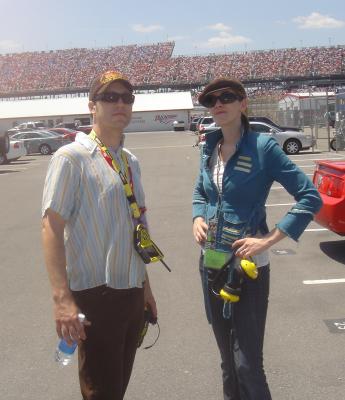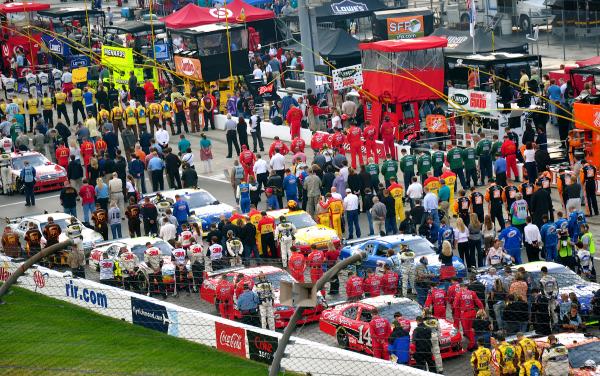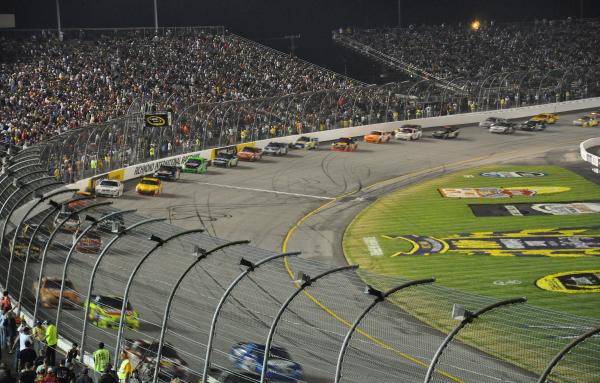 The action at the Talladega Superspeedway.At dawn on a hazy autumn morning, the rising sun spilled over the steel grandstands of the Talladega Superspeedway like foam from a cracked can of Bud. This image likely came to mind because I was lying beneath a tarp in a scrubby Alabama meadow carpeted with empty beer cans — an area known as Talladega’s Family Parking Field C. The 2.66-mile Talladega racetrack, located about 50 miles east of Birmingham, is the world’s second-largest car-racing venue, with a mile-long grandstand built to accommodate more than 140,000 fans. Around my L.L. Bean tent were some 40,000 parked vehicles, most of them flatbeds, SUVs, Winnebagos, and camper vans filled with groggy pilgrims rising to greet a day that would bring them the nation’s biggest semiannual NASCAR racing event.
The action at the Talladega Superspeedway.At dawn on a hazy autumn morning, the rising sun spilled over the steel grandstands of the Talladega Superspeedway like foam from a cracked can of Bud. This image likely came to mind because I was lying beneath a tarp in a scrubby Alabama meadow carpeted with empty beer cans — an area known as Talladega’s Family Parking Field C. The 2.66-mile Talladega racetrack, located about 50 miles east of Birmingham, is the world’s second-largest car-racing venue, with a mile-long grandstand built to accommodate more than 140,000 fans. Around my L.L. Bean tent were some 40,000 parked vehicles, most of them flatbeds, SUVs, Winnebagos, and camper vans filled with groggy pilgrims rising to greet a day that would bring them the nation’s biggest semiannual NASCAR racing event.
The National Association for Stock Car Auto Racing claims to hold “17 of the top 20 most-attended U.S. sporting events.” I had come to see what may rank among the world’s most lavish displays of fuel consumption: 40 hot rods, each getting about 5 miles per gallon, hurtling around a strip of asphalt in an infinite loop. This was my first visit to a NASCAR event, and I admit I came with a certain lack of regard for its premise: burning huge amounts of fuel and rubber for the sole purpose of driving around in circles. The ritual seemed careless to me at a time of war in the Middle East, unchecked global warming, and soaring energy prices. But hours later I would leave Talladega with a less skeptical take on the NASCAR phenomenon and a better understanding not just of carburetors and checkered flags but of who we are as a nation — a thrill-seeking, speed-loving, self-propelled, forward-charging culture.
Talladega is NASCAR’s XXL, Big Gulp–sized speedway — the most treacherous and most exciting. Its long straightaways and unusually wide track allow for cars to build up to and sustain speeds of more than 200 mph and to run three or four abreast. Racers don’t brake for turns at Talladega the way they do at smaller tracks; instead they mash their gas pedals to the floor. These conditions raise fans’ expectations for the “big one” — a massive, harrowing multicar wreck.
NASCAR grew out of the 1930s Prohibition era in America’s Deep South, when rural bootleggers rigged standard-looking cars with high-powered engines to outrun the law. The forefathers of NASCAR, wrote historian Neal Thompson, were “a bunch of motherless, dirt-poor southern teens driving with the devil in jacked-up Fords full of corn whiskey — the best means of escape a southern boy could wish for.”
*
Field C, which a week earlier had housed only wildflowers and Alabama Longleaf pines, was now a sprawling tribal village with makeshift neighborhoods and orderly avenues.
Families had been dwelling there for days before the race, many erecting well-appointed encampments with awnings trimmed in Christmas lights, lawn chairs, picnic tables, movie projectors, grills, and coolers stocked with cold American beer. Hoisted above the camps were Confederate flags and tributes to the denizens’ favorite racers.
I had awoken to the ambient stench of beer-soaked crabgrass, cigarette butts, fire pits, and the charbroiled remains of last night’s cookouts. I groped for soap and toothpaste and made my way to a public trailer marked “$5 Showers.” En route, I caught sight of my neighbor shuffling out of his tent wearing nothing but his briefs. He nodded hello, and as he leaned over a propane stove to flip his pancakes, I saw the numeral 8 shaven expertly into his thicket of back hair — a brash, intimate, and wholehearted display of fan loyalty. This tribute to Dale Earnhardt Jr. (whose number has since changed to 88) was a single-digit poem about America’s devotion to speed.
 Little and her NASCAR-savvy guide in front of the grandstands.At 1:00 p.m. — just after the national anthem blared over the loudspeakers and a squadron of B-1 bombers buzzed overhead — the green flag dropped. In seconds the chorus of twelve-cylinder combustion engines was echoing through the grandstands with a collective shriek as though the universe was being torn in two. Speed rumbled through the ground and into my bones, and my heart knocked against my rib cage. The air filled with the acrid odor of burnt rubber, hot asphalt, and spilled fuel.
Little and her NASCAR-savvy guide in front of the grandstands.At 1:00 p.m. — just after the national anthem blared over the loudspeakers and a squadron of B-1 bombers buzzed overhead — the green flag dropped. In seconds the chorus of twelve-cylinder combustion engines was echoing through the grandstands with a collective shriek as though the universe was being torn in two. Speed rumbled through the ground and into my bones, and my heart knocked against my rib cage. The air filled with the acrid odor of burnt rubber, hot asphalt, and spilled fuel.
For an up-close, under-the-hood look at the action, I made my way into the pit — the restricted area in the center of the track where the cars are fueled and tuned between laps.
Each of the drivers has a pit crew of more than a dozen mechanics responsible for gassing the cars, changing the tires, cooling the engines, and assessing track and vehicle conditions throughout the race. The mechanics were outfitted in helmets and matching Crayola-colored jumpsuits — cherry red, royal blue, canary yellow. Their polished metal tools–wrenches, jacks, pressurized gas pumps shaped like giant baby bottles–glinted in the sunlight.
Between pit stops, as mechanics lounged on spare tires and casually dragged on cigarettes, I pressed them for some answers about NASCAR’s fuel consumption. The cars get anywhere from 4 to 7 miles per gallon, which means that in a 500-mile race such as this one, averaging 5 mpg, each car would consume roughly 100 gallons of fuel. Multiply that by 43 cars per race, and each event as a whole consumes approximately 4,375 gallons of gasoline (assuming all cars finish). With about 96 U.S. NASCAR races per year spread out across several divisions, that totals over 1 million gallons (factoring practice rounds and adjusting for some shorter races).
You also have to factor in the tires for every race. Several gallons of oil go into the production of a synthetic rubber tire. One car competing in a NASCAR event burns through 40 to 80 tires per race. Additionally, each team has a convoy of 18-wheelers that hauls its race cars across the country from track to track, cumulatively traveling hundreds of thousands of miles per year. Fully loaded, these trucks get around 4.5 miles per gallon, which means that millions of gallons are consumed in just getting the cars to the races.
These numbers are small when compared to the volume of fuel that goes into America’s military endeavors or our daily commutes, let alone our total oil demand. What’s fascinating about this particular form of fuel consumption is that its purpose is sheer entertainment. This is gas consumption as an art form.
 Drivers and crews pause before the race to say the Pledge of Allegiance.Looking up at the grandstands, I was struck by the appearance of the crowd. For all the wealth of competing logos and gear available to them, by far the stand-out choice among the Talladega fans was patriotic garb: the grandstands looked like a pointillist painting in red, white, and blue. I approached one bystander, a 63-year-old account manager at a North Carolina carpet company who had been coming to NASCAR races since they were held on dirt tracks in the 1950s, and asked him about this apparent connection between stock car racing and patriotism. “Those fellas are fast, proud, fearless go-getters with rebel hearts,” he said, nodding toward the track. “That about sums up the American spirit, don’t it?”
Drivers and crews pause before the race to say the Pledge of Allegiance.Looking up at the grandstands, I was struck by the appearance of the crowd. For all the wealth of competing logos and gear available to them, by far the stand-out choice among the Talladega fans was patriotic garb: the grandstands looked like a pointillist painting in red, white, and blue. I approached one bystander, a 63-year-old account manager at a North Carolina carpet company who had been coming to NASCAR races since they were held on dirt tracks in the 1950s, and asked him about this apparent connection between stock car racing and patriotism. “Those fellas are fast, proud, fearless go-getters with rebel hearts,” he said, nodding toward the track. “That about sums up the American spirit, don’t it?”
I’d take it a bit further to say that no consumer product more wholly embodies the American ethos than the automobile — “the heartbeat of America,” as Chevrolet famously dubbed it. The word derives from the Greek root auto, “self,” and the Latin mobile, “moving”–words that could be said to define the American dream: we each propel ourselves toward the life and destiny of our own choosing. In these individual pursuits, we also directly consume on average 1.5 gallons of gasoline per person per day. This fuel consumption — roughly quadruple that of the average European — is due in part to the great distances traveled in our sprawled-out, auto-dependent lifestyles, but also to the fact that we have some of the lowest fuel economy standards of any industrial nation — lower even than those of our up-and-coming rival China. All of which contributes to a habit of domestic consumption that far exceeds our ability to produce domestic oil.
Our penchant for long-distance driving is not surprising in a geographically expansive country that now has nearly 4 million miles of heavily subsidized, well-maintained roadways, low gas taxes, and a hobbled rail system — a country in which driving has become, on the whole, significantly more convenient than public transit. Even in the summer of 2008, when gas prices hit record highs, some three-quarters of Americans vacationed in cars. According to the Department of Transportation, the average American driver travels between 30 and 40 miles per day or nearly 14,000 miles a year — the distance around the equator every 1.8 years.
Packing up my sagging tent in Field C at Talladega, I struck up a conversation with an amiable family from Missouri camped out nearby. The four boys, aged 12 to 19, and their parents had driven 600 miles from home in an RV they’d named “Bigfoot.” It’s a voyage they make every year because, as one of the kids told me, “Getting here is half the fun.”
I asked how much their fuel bills — in a Winnebago that gets 8 mpg — had been affected by rising gas prices. The father, a tall, bearded man in his fifties cooking a hot dog on a fork over his smoldering fire pit, answered, “It’ll cost you. But we adapt — cutting back on the restaurant stops, maybe going direct instead of taking the scenic route.” But, he conceded, if oil prices keep going up, eventually Bigfoot may not be able to make the journey.
As I surveyed the sea of campers and Winnebagos in Field C, I wondered what would happen to this scene if oil stopped flowing tomorrow. The answer, simply, is that NASCAR would go with it, along with a piece of the American identity and a slice of the American dream.
This piece was excerpted from Amanda Little’s book Power Trip: From Oil Wells to Solar Cells—Our Ride to the Renewable Future.



